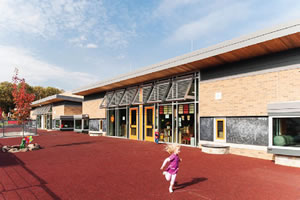Arlington County Public Schools

To encourage individuals and teams to cross-pollinate and engage in a broader range of diverse activities required rethinking the interior landscape and the role of furniture as a mobile tactical toolkit.
THE CHALLENGE
Discovery Elementary School is the first new elementary school to be built in Arlington, Va. in more than a decade. Recognizing that students are the creators of our collective future, Discovery Elementary sets the stage for hands-on student engagement necessary for the development of life-long sustainable stewardship of our world.
The challenge of the project was to address the growing student enrollment in Arlington while also reaching for the highest building performance and human health goals possible — on a tight urban site with an existing Middle School. To this end, careful attention was focused on designing and building a compact “net zero” energy school to support the creative, kinetic and joyful ways children learn and connect within their community. Every nook and cranny of the school is designed to create a seamless integration between sustainable living, learning and playing in the heart of an urban neighborhood. The hillside solution created the opportunity to layer and weave interior and exterior learning terraces with access across grade levels. The public plaza and learning promenade provide social mixing while nestling the intimate and sensory aspects of early childhood learning within the arms of the community in the south-facing Kinderhouses.
THE SOLUTION
An Active Sense of Place. Designed with a holistic, whole child approach emphasized health and well being as a precursor for deep life-long learning. Utilizing the principles of both the Healthy Eating Design Guidelines and the newly published Physical Activity Design Guidelines; Discovery Elementary was planned and designed for the next generation of vibrant, active kids to collaborate, connect, engage and co-create their learning futures. At Discovery Elementary, learning in and from nature, having access to a diversity of outdoor playscapes, engaging with ergonomic and dynamic interior settings all serve to foster a student-centered environment.
IMPACT ON LEARNING
To encourage individuals and teams to cross-pollinate and engage in a broader range of diverse activities required rethinking the interior landscape and the role of furniture as a mobile tactical toolkit. As a result of the architecture and furniture, Discovery’s Active School settings are easy to transform across a range of activities in and beyond the studio for the fluid exchange of ideas and collaborative learning in motion — while at the same time promoting healthy movement with stand-up surfaces, interactive creativity walls, comfy lounges and smart mobile storage that bring resources close to the source of action.
At Discovery Elementary, the future of learning is now. With a reconfigurable range of active spaces and a variety of furniture, both in characteristic and size, the positive relationships between new pedagogic methods, student engagement and high performance architecture have become a centerpiece for the local community. The future of learning; creativity, curiosity and joy made visible through this creative knowledge community and living lab for sustainable, active practices.
Editor’s Review
“Teaching with the Brain in Mind” 2nd Edition, written by Eric Jensen and published by The Association for Supervision and Curriculum Development (ASCD), says that strong evidence supports the connection between movement and learning. Evidence from imaging sources, anatomical studies, and clinical data shows that moderate exercise enhances cognitive processing. It also increases the number of brain cells. And as a bonus, it can reduce childhood obesity. Schools that do not implement a solid physical activity program are shortchanging student brains and their potential for academic performance. Discovery Elementary obviously understands this and made furniture and design choices that will help students learn.
This article originally appeared in the issue of .